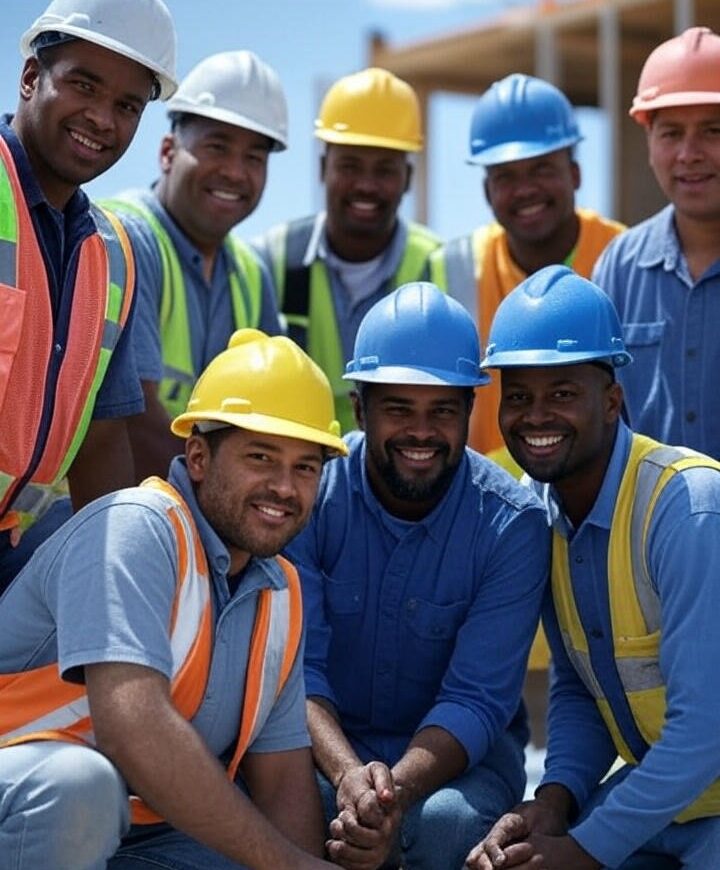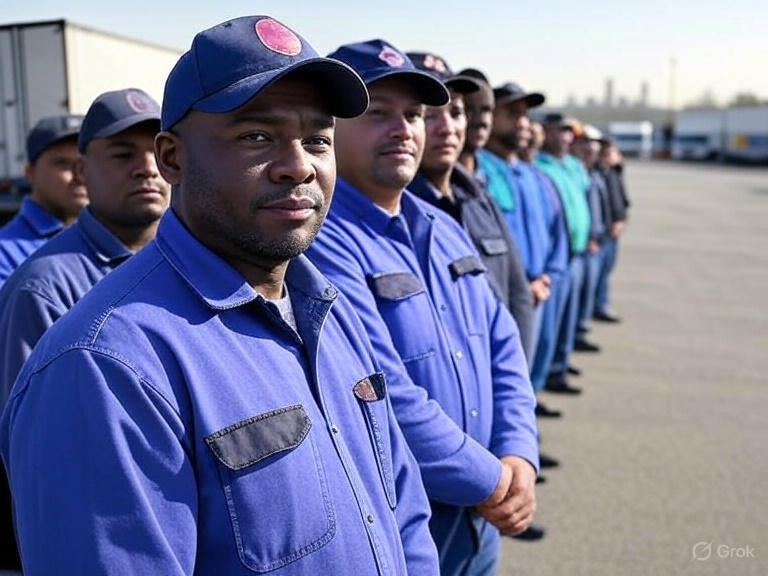The United States’ construction industry is a cornerstone of its economy, driven by a $1.2 trillion Infrastructure Investment and Jobs Act, booming housing markets, and the rapid expansion of renewable energy projects.
In 2024, the sector employed over 7.9 million workers, yet faced a staggering shortage of 488,000 unfilled jobs, according to the Associated General Contractors of America (AGC).
This labor gap, exacerbated by an aging workforce and declining interest in trade careers among U.S. youth, has created a robust demand for skilled foreign workers.
The H-2B visa program, designed for temporary non-agricultural roles, offers a vital pathway for international professionals to fill construction positions such as carpenters, electricians, welders, and laborers, while securing visa sponsorship.
This comprehensive guide, explores the landscape of construction jobs in the USA with visa sponsorship for 2025, detailing the job market, visa processes, requirements, application strategies, benefits, responsibilities, and challenges.
Drawing on data from the U.S. Department of Labor (DOL), U.S. Citizenship and Immigration Services (USCIS), and industry trends, it provides a roadmap for global talent to build rewarding careers in the USA’s dynamic construction sector.
Construction workers are essential to America’s infrastructure, from building highways and bridges to installing solar farms and constructing high-rise developments in cities like Miami, Houston, and Phoenix. Visa sponsorship enables non-U.S. citizens to work legally, with employers providing job offers that facilitate H-2B visa applications.
In fiscal year 2025, the H-2B program expanded with a supplemental allocation of 64,716 visas, on top of the standard 66,000, to address urgent labor needs. With competitive wages ($18-$35/hour) and opportunities in high-demand regions, construction jobs offer financial stability and professional growth.
This guide equips aspiring workers with the tools to navigate the job market, secure sponsorship, and thrive in the USA, whether framing homes in Florida or welding pipelines in Texas.
The Construction Job Market in the USA 2025
The U.S. construction industry is experiencing unprecedented growth, fueled by:
- Infrastructure Investments: The 2021 Infrastructure Act allocates $1.2 trillion for roads, bridges, airports, and public transit, creating millions of jobs through 2030.
- Housing Demand: A shortage of 4 million homes drives residential construction, particularly in Sun Belt states like Texas, Florida, and Arizona.
- Renewable Energy: A target of 50% renewable energy by 2030 requires workers for solar farms, wind turbines, and grid upgrades, with $370 billion in federal funding.
- Commercial Development: Urban centers like New York, Los Angeles, and Dallas see high-rise office and retail projects, with 68% of contractors reporting increased workloads in 2024 (AGC).
- Disaster Recovery: Hurricanes and wildfires necessitate rebuilding, especially in Florida and California.
The DOL’s Occupational Outlook Handbook projects 296,000 new construction jobs by 2032, with immediate shortages in 2025 for roles like:
- Carpenters: Median wage $54,200/year, needed for framing and formwork.
- Electricians: Median wage $61,590/year, critical for wiring and renewable energy.
- Welders: Median wage $50,590/year, essential for pipelines and infrastructure.
- Construction Laborers: Median wage $44,730/year, supporting diverse tasks.
- Masons and Roofers: Median wages $51,510-$48,700/year, in demand for residential and commercial projects.
High-demand states include Texas (21,800 H-2B workers certified in 2023), Florida (18,200), and California (12,500).
Urban hubs like Houston, Miami, and Phoenix, and rural areas with renewable energy projects, offer abundant opportunities. Major employers sponsoring H-2B visas include:
- Construction Firms: Turner Construction, Bechtel, and Kiewit, leading infrastructure and commercial projects.
- Energy Companies: NextEra Energy and Sempra Energy, focusing on renewables.
- Residential Builders: Lennar Homes and D.R. Horton, addressing housing shortages.
- Regional Contractors: Small firms in states like Arizona and Georgia, facing acute labor gaps.
Job boards like Indeed and CareerBuilder list 2,500+ visa-sponsored construction jobs in 2025, with peaks in spring (March-May) and summer (June-August) due to project cycles.
English proficiency is often required for safety, though basic skills suffice for laborers. The next section details the H-2B visa and sponsorship process.
How the H-2B Visa Program Works
The H-2B visa program, authorized under the Immigration and Nationality Act, allows U.S. employers to hire foreign nationals for temporary non-agricultural jobs when no qualified U.S. workers are available.
In construction, this includes seasonal or peak-load roles like carpentry, welding, and laboring, often tied to infrastructure projects, housing developments, or disaster recovery.
The program is critical in addressing labor shortages, with 68% of contractors reporting project delays due to insufficient workers in 2024 (AGC).
Visa Cap and Allocation
The H-2B program has a statutory cap of 66,000 visas annually, split evenly between the first half (October 1–March 31) and second half (April 1–September 30) of the fiscal year. In FY 2025, DHS and DOL added a supplemental allocation of 64,716 visas, including:
- 44,716 for returning workers (those with H-2B status in FY 2022-2024).
- 20,000 reserved for nationals of El Salvador, Guatemala, Honduras, Haiti, Colombia, Ecuador, and Costa Rica, exempt from the returning worker requirement.
This expansion ensures access to critical roles, with the early second-half cap (19,000 visas) exhausted by April 18, 2025, and late second-half visas (May 15–September 30) available until September 15, 2025.
Employer Process
- Prevailing Wage Determination (PWD): Employers request a PWD from the DOL’s National Prevailing Wage Center, ensuring wages meet local standards (e.g., $28/hour for electricians in Florida). Processing takes 2-4 weeks.
- Temporary Labor Certification: Employers conduct a labor market test, advertising jobs via State Workforce Agencies for 10 days. If no U.S. workers apply, they submit Form ETA-9142B to the DOL, proving a labor shortage. Processing takes 30-60 days.
- USCIS Petition: Employers file Form I-129, requesting H-2B status for up to 25 workers per petition. The fee is $1,500 ($750 for small businesses), with processing taking 60-90 days. Supplemental visas require an attestation of irreparable harm (e.g., financial loss without workers).
Worker Process
Approved workers apply for an H-2B visa at a U.S. embassy/consulate or seek direct admission if visa-exempt (e.g., certain Canadians). The visa is valid for up to 9 months, extendable to 3 years, with a 3-month return home required before reapplying. Employers cover inbound travel, visa fees, and subsistence by the contract’s midpoint and outbound travel upon completion. FY 2025’s temporary portability allows workers to switch employers without reapplying, enhancing flexibility.
The H-2B program aligns with construction’s seasonal needs, supporting projects like summer housing builds or winter disaster recovery. The next section outlines worker requirements.
Requirements for Foreign Workers
To qualify for H-2B construction jobs with visa sponsorship, foreign workers must meet USCIS and DOL criteria, ensuring suitability for temporary roles and compliance with immigration laws.
- Country Eligibility: Applicants must be from H-2B-eligible countries, listed in the Federal Register. The 2025 list includes over 80 nations, such as Mexico, Jamaica, Philippines, South Africa, and the 20,000-visa allocation countries (El Salvador, Guatemala, Honduras, Haiti, Colombia, Ecuador, Costa Rica).
- Job Offer: A formal offer from a U.S. employer with an approved Temporary Labor Certification is required. The role must be temporary, tied to seasonal or peak-load needs (e.g., summer construction projects).
- Skills and Experience:
- Laborers: No formal education; physical stamina and 0-1 year of experience.
- Carpenters/Masons: 1-3 years of experience or training in framing, formwork, or masonry.
- Electricians/Welders: 2-5 years of experience, with certifications (e.g., journeyman equivalent) or skills assessments (e.g., Trades Recognition Australia for electricians).
- Evidence includes work references, training certificates, or employer attestations.
- English Proficiency: Basic English is required for safety and communication, especially for skilled roles. Laborers need minimal proficiency, while electricians or supervisors require conversational skills (equivalent to IELTS 4.5). Employers and consular officers assess this.
- Intent to Return: Applicants must demonstrate ties to their home country (e.g., family, property, employment) to prove they will return after the visa expires, avoiding denials based on immigration intent.
- Health and Background: A clean criminal record (police certificate from home country and residences over 6 months) and physical capability for demanding tasks are required. Health exams, including vaccinations, may be requested.
- Returning Worker Status (if applicable): For supplemental visas, applicants need prior H-2B status in FY 2022-2024, verified by visa records. The 20,000-visa allocation is exempt.
A valid passport (6 months beyond stay) and initial financial stability are also needed, though employers reimburse many costs. These requirements ensure workers are equipped for construction’s physical and technical demands.
The Visa Application and Job Search Process
Securing a visa-sponsored construction job involves job hunting, application preparation, and visa processing. Below is a detailed roadmap for 2025.
Step 1: Research and Find Jobs
- Job Portals:
- Indeed: 1,500+ visa-sponsored construction jobs, with filters for “H-2B visa.”
- CareerBuilder: 700+ roles, including laborers and electricians.
- DOL Seasonal Jobs: Lists H-2B jobs, with 400+ construction positions.
- Workforce Solutions: Regional boards in Texas and Florida post 300+ sponsored roles.
- Company Websites: Turner Construction, Bechtel, NextEra Energy, and Lennar Homes advertise visa-supported jobs.
- Recruitment Agencies: Labor Finders, Alliance Abroad, and H2B Programs connect workers with sponsors, charging $500-$2,000.
- Networking: Join LinkedIn groups (“Construction Jobs USA”) and expat forums (Reddit’s r/immigration). Virtual job fairs by Workforce Solutions offer employer access.
Step 2: Prepare Application Materials
- Resume: Highlight construction experience, skills (e.g., welding, wiring), and safety training. Include visa eligibility.
- Cover Letter: Tailor to the employer, emphasizing relevant skills and relocation readiness. Keep it concise (half-page).
- Documents: Provide work references, training certificates, and translated qualifications ($50-$100/document). Skilled roles may require skills assessments.
Step 3: Apply and Interview
- Applications: Submit via portals or company websites. Follow up within 7-10 days.
- Interviews: Expect questions on skills (e.g., “How do you ensure site safety?”) and visa knowledge (e.g., “Are you familiar with H-2B?”). Practice English responses. Remote interviews need stable internet; in-person interviews require business casual attire.
- Job Offer: The employer provides a contract, initiating the visa process.
Step 4: Apply for H-2B Visa
- Employer Steps: The employer secures PWD, labor certification, and files Form I-129.
- Worker Steps:
- Submit Form DS-160 at a U.S. embassy/consulate.
- Provide:
- Passport and photos
- Form I-797 (I-129 approval)
- Job offer letter
- Proof of home ties (e.g., family documents)
- Criminal record certificate
- Pay $190 visa fee and $185-$205 processing costs.
- Attend a consular interview (5-10 minutes) on job details and intent to return.
- Processing Time: 2-4 weeks for visas, 60-90 days for I-129.
- Entry: Enter the U.S. within 10 days of the job start date.
Step 5: Start Employment
- Employers provide OSHA-compliant training, tools, and orientation. Begin work within 10 days.
Engaging an immigration attorney ($1,500-$3,000) can streamline the process, though self-application is viable with preparation.
Benefits and Responsibilities
H-2B construction jobs offer significant benefits, balanced by responsibilities.
Benefits
- Wages: $18-$35/hour, with annual earnings of $37,440-$72,800 for 40-hour weeks over 9 months. Overtime (1.5x) adds $5,000-$15,000.
- Employer-Paid Costs: Reimbursed inbound travel ($1,000-$2,000), visa fees ($375-$395), and outbound travel, per DOL rules.
- Legal Status: Up to 9 months, extendable to 3 years, with equal protections (e.g., workers’ compensation).
- Career Growth: U.S. experience enhances skills in OSHA standards and advanced techniques, boosting global employability.
- Family Accompaniment: H-4 status for spouses and children under 21, allowing U.S. residence (not work).
- Pathway to PR: H-2B experience supports EB-3 visa applications, with 2,000+ construction workers gaining PR annually.
Responsibilities
- Visa Compliance: Work only for the sponsor; overstaying risks a 3-10-year ban.
- Performance: Meet safety and productivity standards, per OSHA and employer policies.
- Taxes: Pay federal/state taxes (10-30% on wages). File Form 1040NR.
- Safety: Use protective gear, attend training, and report hazards.
- Reporting Abuse: Report wage theft or unsafe conditions to DOL’s Wage and Hour Division (1-866-487-9243).
Challenges and Strategies
- Visa Cap: Apply early (October/April) to secure one of 130,716 visas.
- Competition: Target regional contractors and use agencies like Alliance Abroad.
- Living Costs: Budget $2,500-$4,000/month in cities like Miami. Seek employer housing support.
- Scams: Verify employers via DOL’s H-2B database; avoid upfront payments.
- Language: Improve English via apps like Duolingo to meet safety requirements.
Conclusion
Construction jobs in the USA with visa sponsorship offer global workers a chance to join a booming industry in 2025. With 488,000 vacancies, competitive wages, and H-2B visas, roles like carpentry and welding provide stability and growth.
Start by exploring Indeed, networking on LinkedIn, and preparing applications. Secure a job offer, navigate the visa process, and leverage employer benefits to thrive.
Whether building bridges in Texas or solar farms in California, your construction career awaits. Act now—apply early and build your American dream.




